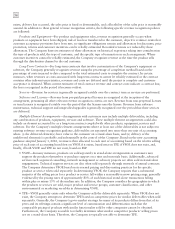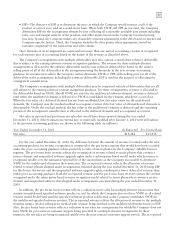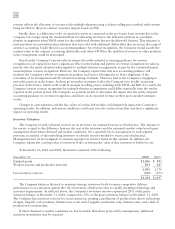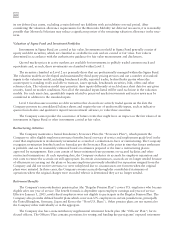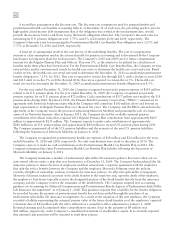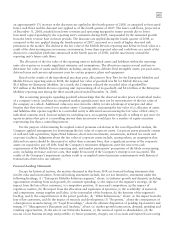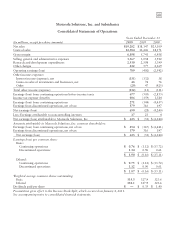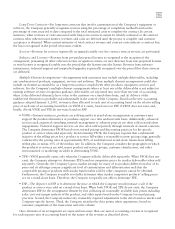Motorola 2010 Annual Report Download - page 73
Download and view the complete annual report
Please find page 73 of the 2010 Motorola annual report below. You can navigate through the pages in the report by either clicking on the pages listed below, or by using the keyword search tool below to find specific information within the annual report.
65
an approximately 1% increase in the discount rate applied in the fourth quarter of 2008, as compared to forecasted
future cash flows and the discount rate applied as of the fourth quarter of 2007. The lower cash flows, projected as
of December 31, 2008, resulted from lower revenues and operating margins for future periods due to lower
forecasted capital spending by the reporting unit’s customers during 2009, compounded by the estimated growth
from the lower revenue base in future periods. The discount rate applied during the fourth quarter of 2008, as
compared to the rate applied during the fourth quarter of 2007, increased as a result of higher observed risk
premiums in the market. The decline in the fair value of the Mobile Devices reporting unit below its book value is a
result of the deteriorating macroeconomic environment, lower than expected sales and cash flows as a result of the
decision to consolidate platforms announced in the fourth quarter of 2008, and the uncertainty around the
reporting unit’s future cash flows.
The allocation of the fair value of the reporting units to individual assets and liabilities within the reporting
units also requires us to make significant estimates and assumptions. The allocation requires several analyses to
determine fair value of assets and liabilities including, among others, definite-lived intangible assets, pre-paid assets,
deferred taxes and current replacement costs for certain property, plant and equipment.
Based on the results of the hypothetical purchase price allocation in Step Two for the Enterprise Mobility and
Mobile Devices reporting units in 2008, the implied fair value of goodwill was $0 for Mobile Devices and
$1.0 billion for Enterprise Mobility. As a result, the Company reduced the recorded value of goodwill by
$55 million at the Mobile Devices reporting unit (representing all of its goodwill) and $1.6 billion at the Enterprise
Mobility reporting unit during the three-month period ended December 31, 2008.
The accounting principles regarding goodwill acknowledge that the observed market prices of individual trades
of a company’s stock (and thus its computed market capitalization) may not be representative of the fair value of
the company as a whole. Additional value may arise from the ability to take advantage of synergies and other
benefits that flow from control over another entity. Consequently, measuring the fair value of a collection of assets
and liabilities that operate together in a controlled entity is different from measuring the fair value of that entity’s
individual common stock. In most industries, including ours, an acquiring entity typically is willing to pay more for
equity securities that give it a controlling interest than an investor would pay for a number of equity securities
representing less than a controlling interest.
For the purpose of determining the implied control premium calculation in the overall goodwill analysis, the
Company applied assumptions for determining the fair value of corporate assets. Corporate assets primarily consist
of cash and cash equivalents, Sigma Fund balances, short-term investments, investments, deferred tax assets and
corporate facilities. Judgments about the fair value of corporate assets include, among others, an assumption that
deferred tax assets should be discounted to reflect their economic lives, that a significant portion of the corporate
assets are required to pay off debt, fund the Company’s retirement obligations, meet the near term cash
requirements of the Mobile Devices reporting unit, and market participants’ perceptions of the likely restructuring
costs, including severance and exit costs, that might be incurred if the Company’s strategy is not successful. The
results of the Company’s impairment analysis result in an implied control premium commensurate with historical
transactions observed in our industry.
Forward-Looking Statements
Except for historical matters, the matters discussed in this Form 10-K are forward-looking statements that
involve risks and uncertainties. Forward-looking statements include, but are not limited to, statements under the
following headings: (1) “Enterprise Mobility Solutions segment,” about: (a) industry growth and demand, including
opportunities resulting from such growth, (b) customer spending, (c) the impact of the segment’s strategy, (d) the
impact from the loss of key customers, (e) competitive position, (f) increased competition, (g) the impact of
regulatory matters, (h) the impact from the allocation and regulation of spectrum, (i) the availability of materials
and components, energy supplies and labor, (j) the seasonality of the business, (k) the firmness of the segment’s
backlog, and (l) the competitiveness of the patent portfolio; (2) “Other Information,” about: (a) the impact from the
loss of key customers, and (b) the impact of research and development; (3) “Properties,” about the consequences of
a disruption in manufacturing; (4) “Legal Proceedings,” about the ultimate disposition of pending legal matters and
timing; (5) “Management’s Discussion and Analysis,” about: (a) market growth/contraction, demand, spending and
resulting opportunities, (b) the sale of our Networks business, (c) the return of capital to shareholders, (d) the
success of our business strategy and portfolio (e) future payments, charges, use of accruals and expected cost-saving



